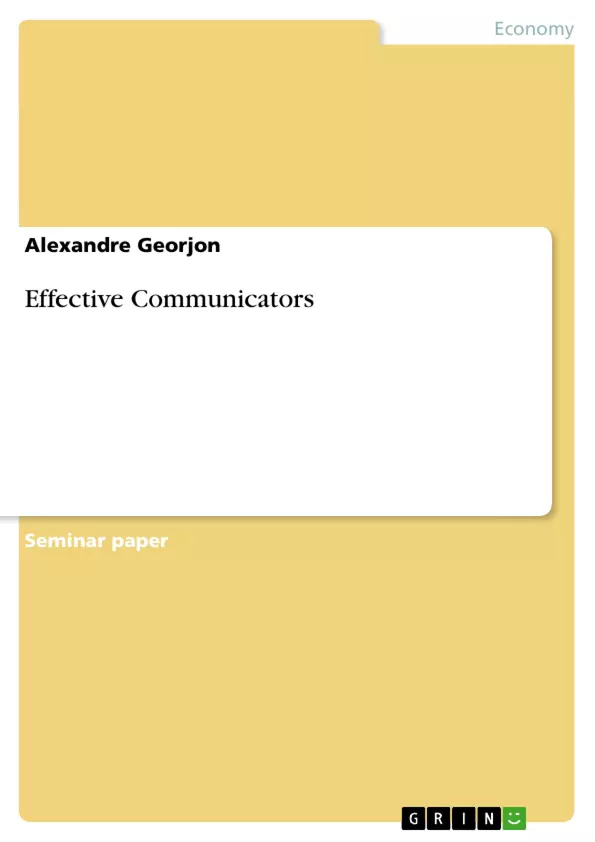Why are the companies seeking ‘effective communication’? According to the
BT Forum Report Communication (cited in Cameron, 2000)1“good communicators lead
happier lives […]; making the effort to communicate is the key to happy relationships with
people […]; the best way to resolve a disagreement between two people is to get them talking
[…] and many arguments would be resolved if people communicated better.”
Despite these clear positive effects in an organisation, the definition of the
concept of communication appears to be less obvious. According to Cameron (2000)2 this
concept is “’Verbal’, ‘vocal’ and ‘visual’. ‘Verbal’ means the actual words; ‘vocal’ means is
linguists’ terms, prosodic and paralinguistic features; and ‘visual’ means gaze, postured and
other aspects of body language.” A priori, an effective communication may appear to be only
depending on the good will of each member of the organisation to communicate with others.
However, this analysis will examine four major factors influencing the quality of
communication. The first variable is the personality and perception of individuals, which is
closely linked with the knowledge and judgment that people have about their congeners. The
second variable is the particular skills of individuals that allow them to reduce
communication’s barriers and noises in order to improve the quality of the communication.
Finally the two last variables are the level of motivation that an individual needs in order to
transmit a message to the audience, and the impact of the respective cultural background of
the interlocutors.
1 Cameron, D. (2000) Good to Talk? London, SAGE Publications Ltd, pp. 149
2 Cameron, D. (2000) Good to Talk? London, SAGE Publications Ltd, pp. 40
Inhaltsverzeichnis (Table of Contents)
- INTRODUCTION
- FOUR FACTORS INFLUENCING THE QUALITY OF COMMUNICATION
- BETTER SELF-KNOWLEDGE LEADS TO MORE EFFECTIVE COMMUNICATION.
- BETTER KNOWLEDGE ABOUT INTERLOCUTORS LEADS TO MORE EFFECTIVE COMMUNICATION.
- ADAPTED MOTIVATION MANAGEMENT LEADS TO MORE EFFECTIVE COMMUNICATION.
- UNDERSTANDING OF CULTURES LEADS TO MORE EFFECTIVE COMMUNICATION.
- CONCLUSION.
- ANNEXE
- ANNEXE 1: JOHARI WINDOW.
- ANNEXE 2: BENZIGER THEORY
- REFERENCES.
Zielsetzung und Themenschwerpunkte (Objectives and Key Themes)
This text explores the crucial role of effective communication in organisations, aiming to provide an in-depth understanding of the factors that contribute to high-quality communication. It seeks to equip readers with knowledge and insights that can be applied in real-world settings to enhance communication practices.
- The importance of self-knowledge and perception in effective communication.
- The impact of individual personality and perception on communication dynamics.
- The role of specific communication skills in overcoming barriers and enhancing quality.
- The influence of motivation levels and cultural background on communication effectiveness.
- The application of models like the Johari Window and Benzinger Thinking Styles Assessment for improving communication.
Zusammenfassung der Kapitel (Chapter Summaries)
Introduction This chapter sets the stage by addressing the critical importance of effective communication in contemporary organisations. It provides evidence from a BT Forum Report that highlights the positive impact of communication on both individual well-being and organisational performance. The chapter also delves into the definition of communication, highlighting the three key aspects: verbal, vocal, and visual. Finally, it introduces the four major factors that influence the quality of communication, which are examined in greater detail throughout the text.
2. Four Factors influencing the quality of Communication This section explores the key factors that significantly influence the effectiveness of communication within organizations. It focuses on the importance of self-knowledge and understanding of others' personalities, and how perception, skills, motivation, and cultural awareness play crucial roles.
2.1 Better Self-Knowledge leads to more effective Communication. This section dives into the impact of self-knowledge and perception on communication. It argues that individuals' personalities, formed by genetics, experience, and environment, significantly influence their communication patterns. The Johari Window theory is introduced as a valuable tool for increasing self-awareness and improving communication. The concept of "Blind" and "Hidden" areas within the Johari Window is discussed, along with strategies for reducing these areas and fostering effective communication.
2.2 Better Knowledge about Interlocutors leads to more effective Communication. This section examines the crucial role of understanding one's interlocutors in effective communication. It introduces Dr. Katherine Benzinger's model (BTSA: Benzinger Thinking Styles Assessment), which highlights the importance of considering different personality profiles and thinking styles in communication. The model emphasizes the importance of selecting team members with complementary strengths and minimizing stress caused by misaligned working styles.
Schlüsselwörter (Keywords)
The primary focus of this text is on interpersonal communication within organisations, exploring factors such as self-knowledge, perception, personality, communication skills, motivation, cultural awareness, and models like the Johari Window and the Benzinger Thinking Styles Assessment. These themes are central to understanding and improving the quality of communication within any organisational setting.
- Citar trabajo
- Alexandre Georjon (Autor), 2004, Effective Communicators, Múnich, GRIN Verlag, https://www.grin.com/document/23363



